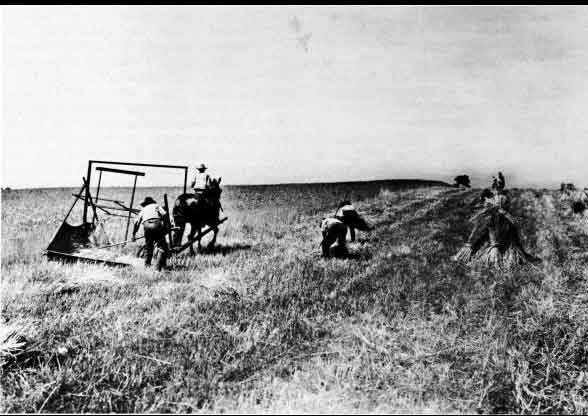Agriculture in Antebellum America

Grain Reaper in the Fields
American agriculture faces a shortage of labor and high worker wages relative to Europe. While this may have hampered agricultural development, the increasing amount of farming land available to American farmers compensated for it. The western expansion allowed many farmers, both large and small, to establish farms. Some progressive farmers, such as Thomas Jefferson, followed European models of fertilization, crop rotation and livestock breeding. Most small farmers did not have the money to apply such techniques. Farmers generally knew little about fertilization, and had few resources in labor and equipment to implement any soil conservation policies that might have been developed. Since land was the easiest major resource to acquire, farmers generally used up a given plot of land, stripping it of its mineral nutrients, and moved on to another plot. For antebellum farmers, this was the most expedient method; although later scientific insights into agriculture would reveal the wastefulness of that approach.
Technological developments also facilitated farming. Through the antebellum period, plows were developed to deal more effectively with various terrains of the West. Jethrow Wood's cast-iron plow made of interchangeable parts (1819) was not strong enough to conquer the hard soil of the prairies. Demand for improved plows compeled many Americans, including Thomas Jefferson and Daniel Webster, to experiment on new models. John Deere developed the first successful all-steel plow in 1847. Obed Hussey and Cyrus McCormick both designed similar reaping machines, in 1833 and 1834 (patented) respectively. By 1855, however, McCormick's machine won out. The popularity of Cyrus McCormick? s reaping machine slowly spread to farms across the country, although they were most extensively used after the Civil War.
The Old Northwest region became a major engine of agricultural growth, due to the large amount of rich fertile soil, suitable for heavy cereal crops. The richness of the prairie soil was not discovered, however, until farmers began using newly developed plows such as Deere's plows. The improvement of transportation, including the building of railroads and the Erie and Ohio Canals, made it possible for Western products to reach Eastern markets, thus increasing potential demand.
New England and Mid-Atlantic farmers faced challenges from the success of western farms and the loss of labor to regional urbanization and industrialization. The growing urban populations, however, created larger local markets for specific products; such as dairy products, fruit and perishables. By the time of the Civil War, much of New England farming would be focussed on producing items to serve the needs of those local cities and towns. For farmers in the South and Southwest, cotton was the profitable crop. By the Civil War, two-thirds of American slaves worked on cotton, and the crop constituted two-thirds of the value of all US exports. Whitney cotton? gins continued to facilitate cotton production; and the industrialization of northern cities, combined with increased demand from England, created a strong market for the southern crop. I. M. Singer's invention development of a sewing machine in 1851 further contributed to demand for cotton.
Southern cotton production was closely connected to the southern slave system. A small percentage of southern whites (about 3%) owned large plantations with 20 or more slaves, but up to half of the southern cotton crop was produced from such plantations. The rest came largely from small farmers in the South and especially Southwest, who owned no more than five or six slaves and who often worked alongside their slaves.
 >
>